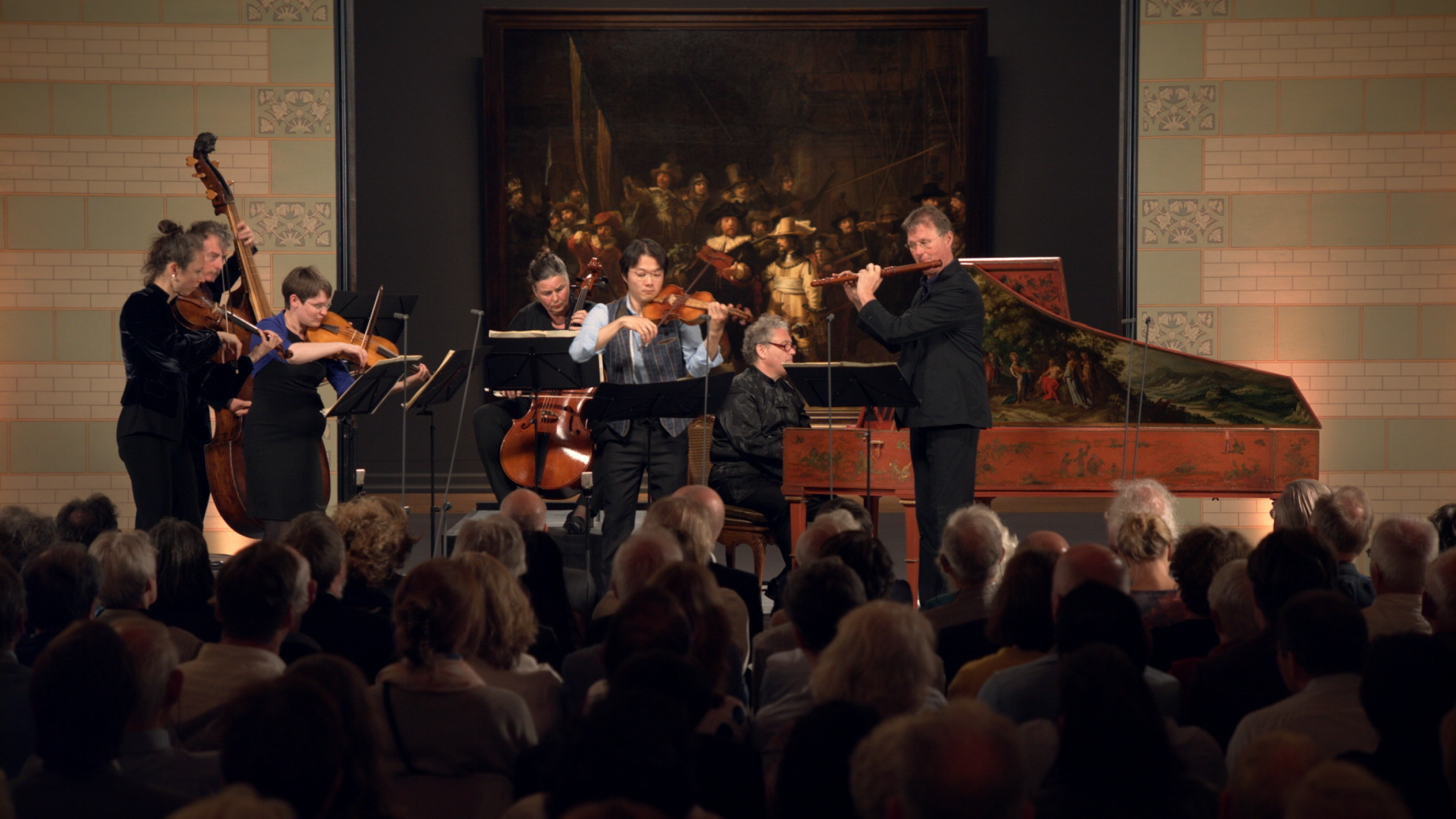'Brandenburg' Concerto No. 5 in D major – Bach (original) (raw)

BWV 1050 performed by the Netherlands Bach Society
conducted by Shunske Sato
Rijksmuseum, Amsterdam
Behind the music
Story
Extra videos
Credits
Bach in the Rijksmuseum
The harpsichord emerges as a solo instrument
For this recording, we were guests at the Gallery of Honour at the Rijksmuseum, in Amsterdam. We were invited to come and perform Bach’s unusual ‘Brandenburg' Concerto no. 5 – in which the harpsichord emerges as a soloist rather than an accompanying instrument – in order to celebrate the loan of an exceptional harpsichord to the museum. For the recording, the original instrument, built by Johannes Ruckers in 1640, was played by harpsichordist Richard Egarr.
Bach and Rembrandt
Bach himself never went to Amsterdam, and Rembrandt never went to Leipzig or Berlin. Yet there were many ties between the Republic of the Netherlands and Bach’s employers. For many young German princes, the Netherlands was a regular destination for a tour or a period of study. Johann Ernst of Saxen-Weimar, for whom Bach was working when he wrote the first versions of the ‘Brandenburg’ concertos, studied for a couple of years in Utrecht, and Christian Ludwig of Brandenburg-Schwedt, to whom he later dedicated these concertos, also studied for a while in Leiden.
Rembrandt’s Night Watch had been hanging since 1642 in Amsterdam in the Kloveniersdoelen, the building of the civic guard depicted on the painting. In 1700, and between 1704 and 1705, Christian’s step-brother Friedrich Wilhelm of Brandenburg, visited the Netherlands. On his second trip, as a young man of sixteen, he visited “everything there was to see”. Might he also have been to the Kloveniersdoelen? In any case, later as the king of Prussia, he based all sorts of things on the Dutch model: painters, carillons, canals and even a ‘Dutch’ hunting lodge, and in the 1730’s a Dutch district in Potsdam.
In 1715, the Night Watch moved to the town hall on Dam Square, and part of it was cut off so it would fit between two doors. The manuscript of Bach’s ‘Brandenburg’ concertos was treated with similar disregard. After Christian Ludwig’s death in 1734, it was sold off for a meagre 24 groschen. Nowadays, both Rembrandt’s paintings and Bach’s music are regarded as icons of European art, and here they are presented as a unique combination for eye and ear.
'Brandenburg' concertos, BWV 1046-1051
In March 1721, Bach sent a manuscript from Köthen to Berlin entitled ‘Six concertos with several instruments’ (Six concerts avec plusieurs instruments), dedicated to Christian Ludwig (1677-1734), Margrave of Brandenburg-Schwedt. In the preface, Bach stated that he had played for the margrave ‘a couple of years ago’ (il y a une couple d’années) and had promised to send him ‘some of his compositions’ (quelques pieces de ma composition). That was probably during a visit to Berlin in March 1719, when Bach had travelled to the Prussian capital to take receipt of a new harpsichord for the court in Köthen. The music that he sent to the margrave a couple of years later (which subsequently became known as the Brandenburg Concertos) was Bach’s ultimate view of the most important large-scale instrumental genre of his day: the concerto.
A concerto nearly always involves a solo instrument (or combination of solo instruments) and an ensemble. The key idea is the alternation between one or more soloists and the whole ensemble, in a sort of light-hearted competition. In the six Brandenburg Concertos, Bach explores every facet of this genre, with regard to both instrumentation and the way in which he handles the form. All the traditionally used string and wind instruments and the harpsichord appear as soloists, the musical forms range from court dances to near-fugues, and the relationship between the solos and tutti instruments is always shifting. Together, the six concertos thus form a virtuoso sample sheet of the Baroque concerto.
Background noise in recording
In this recording, you hear a harpsichord that is over 350 years old: a Johannes Ruckers from 1640. During the concert, the jackrail (the rail above the jacks with plectrums that pluck the strings when the keys are pressed) started to rattle. The tapping you can hear comes from this loose jackrail.
BWV
1050
Title
Concerto in D major
Epithet
'Brandenburg' Concerto no. 5
Instrument
harpsichord, traverso, violin
Genre
orchestral works
Serie
Brandenburg concertos
Year
1719-1720
City
Köthen (but possibly earlier in Weimar)
Occasion
Dedicated in 1721 to Margrave Christian Ludwig of Brandenburg
Extra videos
Shunske Sato and Richard Egarr
“The appearance of the harpsichord as a solo instrument in the concerto form was a groundbreaking move by Bach.”
Vocal texts
Original
Translation
Credits
- Release date
21 September 2018 - Recording date
11 May 2018 - Location
Rijksmuseum, Amsterdam - Harpsichord
Johannes Ruckers, 1640 - Violin and direction
Shunske Sato - Harpsichordist
Richard Egarr - Traverso
Marten Root - Violin 2
Anneke van Haaften - Viola
Femke Huizinga - Cello
Lucia Swarts - Double bass
James Munro - Director and editor
Bas Wielenga - Music recording
Guido Tichelman, Bastiaan Kuijt, Pim van der Lee - Music edit and mix
Guido Tichelman - Camera
Ramon de Boer, Tim van der Voort, Bart Krimp - Lights
Zen Bloot, Henry Rodgers - Camera-assistant/grip
Robin Noort - Assistant director
Ferenc Soeteman - Set technique
Alex de Gier - Data handling
Kira Falticeau - Project manager videobrix
Peter Hazenberg - Interview
Onno van Ameijde, Marloes Biermans - Producer concert
Imke Deters - Producer film
Jessie Verbrugh
Discover
Help us to complete All of Bach
There are still many recordings to be made before the whole of Bach’s oeuvre is online. And we can’t complete the task without the financial support of our patrons. Please help us to complete the musical heritage of Bach, by supporting us with a donation!